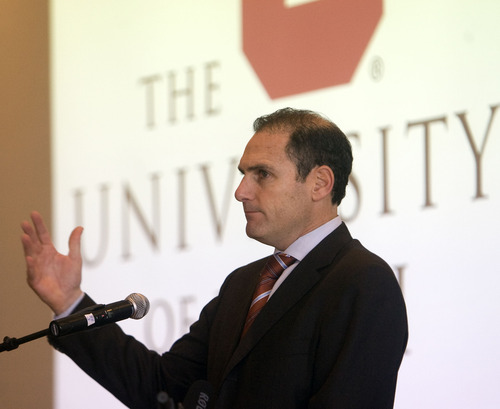This is an archived article that was published on sltrib.com in 2013, and information in the article may be outdated. It is provided only for personal research purposes and may not be reprinted.
Amid concerns over the continuing high rate of head trauma in college athletics, Pac-12 commissioner Larry Scott and the league's presidents and chancellors put their heads together at the league's annual summer meetings and decided something should be done to improve athletes' safety.
The result is the creation of the Student Athlete Health and Well-Being Initiative, Scott announced on Monday.
The initiative, which will start with the 2013-14 academic year and commit $3.5 million in research grants, will conduct research and studies in an effort to reduce injuries, specifically head trauma.
Scott said the league plans to formalize a policy on the amount of contact in football practice, with limits even more stringent than what is allowed under NCAA rules.
The details of the Pac-12 policy will be announced at the Pac-12 Football Media Day on July 26.
Currently, teams are allowed to practice 15 times in the spring, with contact permitted in 12 sessions and full tackle in eight. Three full scrimmages are allowed, including the spring game.
During the season, teams are allowed up to five days of contact, although Scott noted many teams don't hit every day.
"There is a high degree of awareness and a deep commitment from the presidents, athletic directors, coaches and trainers to do what we can collectively," Scott said of minimizing head trauma.
Concern over the amount of cumulative hits athletes, particularly football players, sustain grew after a 2010 study published in the Journal of Athletic Training showed the teams it tracked in a full season had an average of 2,500 hits to the head that measured as significant blows and about 300 hits that were considered in the concussion-causing range.
Each team logged about 200 practice collisions that measured above 120 G's of force, which is comparable to a car crashing into a wall at 40 miles per hour.
In 2011, the Ivy League announced stricter rules that limit teams to just two full-contact practices per week during the season.
Scott declined to give more details on what limitations will be imposed, but likened the stance to what the NFL has done.
The NFL limits teams to 14 practices in full pads a season, 11 of which must come in the first 11 weeks of the 17-week season. Two-a-days — two practices in full pads the same day — are also a thing of the past with one of the practices now deemed a walkthrough.
"We realize football is a contact sport, and a violent sport, but at the same token we need to be responsible toward training and teaching of tackling and hitting the right way," Scott said. "We are trying to analyze what is appropriate in the context of college football, where you are a teacher."
Scott also touched on several other topics including:
• DirectTV: Scott was pessimistic an agreement could be reached with the company to carry the Pac-12 Networks, all but scolding the company. "At this point in time we are as frustrated as our fans are and we hope that DirectTV will listen to their customers and fans and stop depriving fans."
• Officiating: Announced there will be a new leadership and structure for Pac-12 basketball officiating as part of the fallout of the investigation of the incident between coordinator of officiating Ed Rush and Arizona coach Sean Miller at the conference tournament in which Rush offered bounties to any official who disciplined Miller. Rush said the comments were made in jest, but he resigned in April.
• Scheduling: Scott believes conferences will increase the number of conference football games or the quality of nonconference games as strength of schedule becomes more of a priority in determining teams' rankings.
• Bowls: The Pac-12 bowl agreements will be "improved," and announced soon.
• Pac-12 Network: The Pac-12 Networks, projected to make a profit in the first year, will televise 750 live events next season, an increase of 200 events from the first year.



